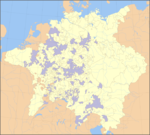- Fraumünster
-
Imperial Abbey of Fraumünster
Reichskloster FraumünsterImperial Abbey of the Holy Roman Empire ← 
←
853–1524  →
→Fraumünster abbey, Münsterhof, old Kornhaus (to the left side) and Zunfthaus zur Meisen. Aquarell by Franz Schmid, showing situation in 1757. Capital Fraumünster Abbey Government Theocracy Historical era Middle Ages - Founded by Louis
the German
21 July 853- Granted market, toll and
minting rights by Henry III
1045- Imp. immediacy
confirmed by Frederick II
1218- Rudolf Brun indep. mayor,
established guild laws
1336- Dissolved in
Zwinglian Reforms
30 November 1524- Buildings destroyed 1898 Today part of  Switzerland
Switzerland The Fraumünster church, the stained glass windows in the choir are by Marc Chagall.
The Fraumünster church, the stained glass windows in the choir are by Marc Chagall.
The Fraumünster abbey (lit. in English: [Our] Lady Minster) in Zurich was founded in 853 by Louis the German for his daughter Hildegard. He endowed the Benedictine convent with the lands of Zurich, Uri, and the Albis forest, and granted the convent immunity, placing it under his direct authority.
Contents
History
In 1045, King Henry III granted the convent the right to hold markets, collect tolls, and mint coins, and thus effectively made the abbess the ruler of the city.
Emperor Frederick II granted the abbey Reichsunmittelbarkeit in 1218, thus making it territorially independent of all authority save that of the Emperor himself, and increasing the political power of the abbess. The abbess assigned the mayor, and she frequently delegated the minting of coins to citizens of the city. However, the political power of the convent slowly waned in the fourteenth century, beginning with the establishment of the Zunftordnung (guild laws) in 1336 by Rudolf Brun, who also became the first independent mayor, i.e. not assigned by the abbess.
The abbey was dissolved on 30 November 1524 in the course of the reformation of Huldrych Zwingli. The monastery buildings were destroyed in 1898 to make room for the new Stadthaus. The church building today serves as the parish church for one of the city's 34 reformed parishes. Münsterhof, the town square in front of Fraumünster, is named after the former abbey.
Chagall windows
The choir of the abbey includes 5 large stained glass windows designed by artist Marc Chagall and installed in 1970. Each of the 5 has a dominant color and depicts a Christian story. From left (northern wall) to right, the 5 works are:
- Prophets, depicting Elijah's ascent to heaven
- Jacob, displaying his combat, and dreams of heaven
- Christ, illustrating various scenes of Christ's life
- Zion, showing an angel trumpeting the end of the world
- Law, with Moses looking down upon the suffering of his people
Equally impressive is the 9m tall stained glass of the North transept, created by Augusto Giacometti in 1940.
Gallery
-
Fresco by Paul Bodmer in Fraumünster's former cloister
-
Fraumünster as seen from Postrasse towards Paradeplatz
-
Fraumünster, Münsterhof and Zunfthaus zur Meisen as seen from Grossmünster
-
Zürich's saints on a fresco by Paul Bodmer: Exuperantius, Felix and Regula
-
Fresco by Paul Bodmer in former cloister
Literature
- Peter Vogelsanger: Zürich und sein Fraumünster. Eine elfhundertjährige Geschichte (853–1956). NZZ Libro, Zürich 1994, ISBN 3-85823-515-6
See also
 Holy Roman Empire — Imperial abbeys of the Swabian College
Holy Roman Empire — Imperial abbeys of the Swabian CollegeImperial abbeys and colleges
(Reichsabteien, Reichsklöster
und Reichsstifte)Baindt • Comburg • Disentis • Elchingen • Frauenchiemsee • Fraumünster • Fürstenfeld • Gengenbach • Göss • Gutenzell • Heggbach • Helmarshausen • Herrenalb • Irsee • Kaisheim† • Lindau • Lorsch • Marchtal • Marmoutier • Maulbronn • Mönchrot • Mondsee • Murbach* • Neresheim • Ochsenhausen • Ottobeuren • Petershausen • Prüfening • Reichenau • Roggenburg • Rottenmünster • St. Gall's* • St. George's in Isny • Salem • Schänis • Schussenried • Schuttern • Söflingen • Ursberg • Waldsassen • Weingarten • Weissenau • WettenhausenImperial charterhouse
(Reichskartause)- Also a Prince of the Empire † Also in Rhenish College
Categories:- Imperial abbeys
- Former theocracies
- Former countries in Europe
- States of the Holy Roman Empire
- States and territories established in 853
- States and territories disestablished in 1524
- Benedictine monasteries in Switzerland
- 850s architecture
- 853 establishments
- Christian monasteries established in the 9th century
- Churches in Zurich
- History of Zurich
- Benedictine nunneries in Switzerland
- Cultural property of national significance in the canton of Zurich
Wikimedia Foundation. 2010.











